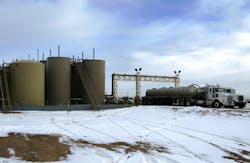The U.S. Geological Survey (USGS) has called for greater public access to data on wastewater injection by oil and gas producers.
The agency highlighted the fact that large areas of the United States that were long considered geologically stable, with few or no earthquakes, have seen a significant increase in earthquake activity in recent years.
This rise in seismic activity, especially in the central United States, is not the result of natural processes, the USGS said. Instead, it has been caused by fluid injection associated with new technologies that enable the extraction of oil and gas from previously unproductive reservoirs.
The disposal of produced water, or wastewater, by deep injection occasionally results in earthquakes that are large enough to be felt, and sometimes these quakes cause damage. According to the USGS, deep injection of wastewater is the primary cause of the dramatic rise in detected earthquakes in the mid-continent.
A paper in Science, which followed a series of workshops led by scientists at the USGS in collaboration with the University of Colorado, Oklahoma Geological Survey and Lawrence Berkeley National Laboratory, suggests that it is possible to reduce the hazard of induced seismicity through management of injection activities.
As co-author Dr. William Ellsworth, a USGS geophysicist, explained, the main goal of the study was to bring about more cooperation among stakeholders — including the oil and gas industry, government agencies, the earth science community and the general public — for the common purpose of reducing the consequences of earthquakes induced by fluid injection.
The lead author of the study, USGS geophysicist Dr. Art McGarr, said: "In contrast to natural earthquake hazard, over which humans have no control, the hazard from induced seismicity can be reduced. Improved seismic networks and public access to fluid injection data will allow us to detect induced earthquake problems at an early stage, when seismic events are typically very small, so as to avoid larger and potentially more damaging earthquakes later on."
Co-author Dr. Barbara Bekins, a USGS hydrologist, stressed the importance of making all relevant information publicly accessible, "because only in this way can it be used to provide the timely guidance needed to reduce the hazard and consequences of induced earthquakes."


